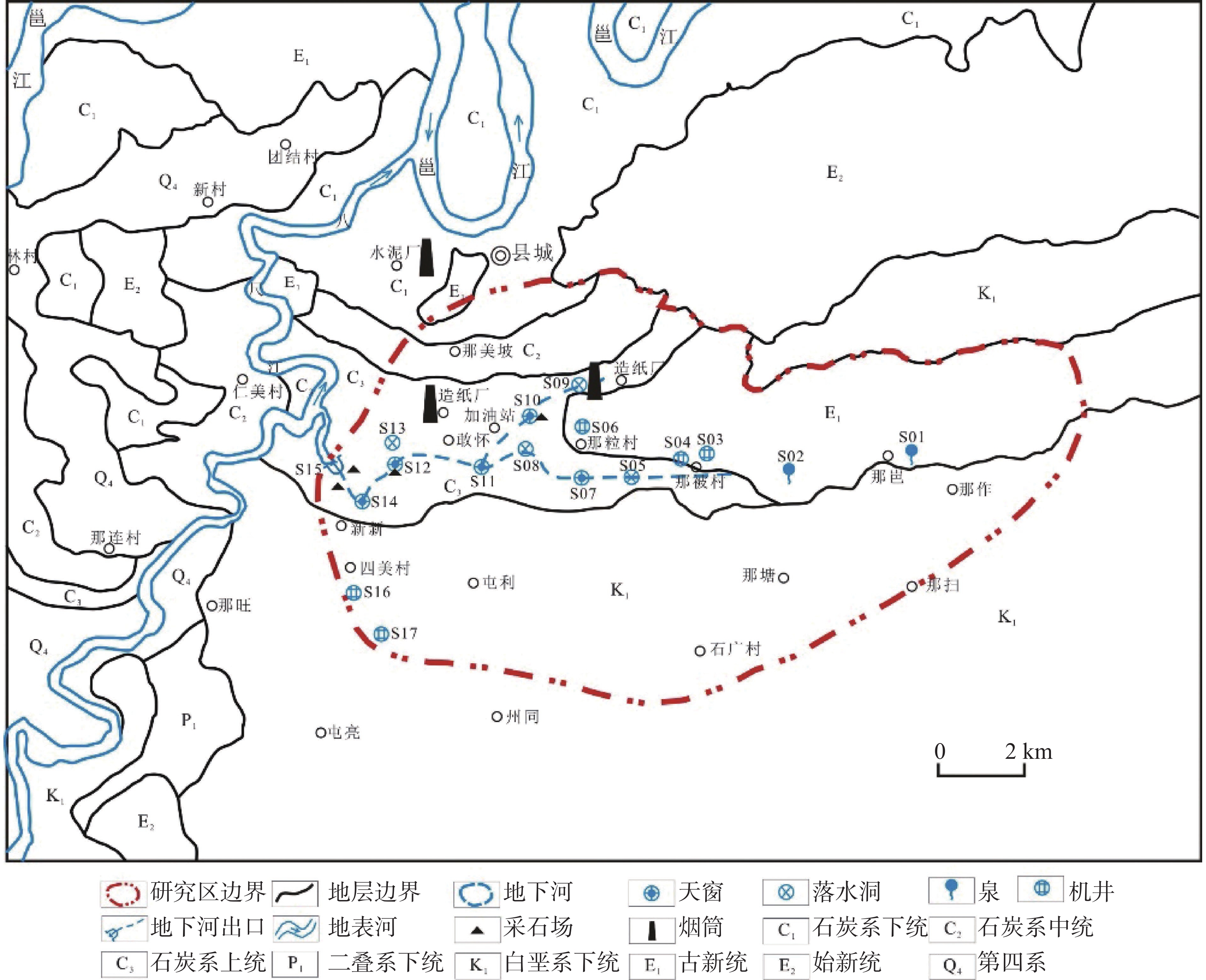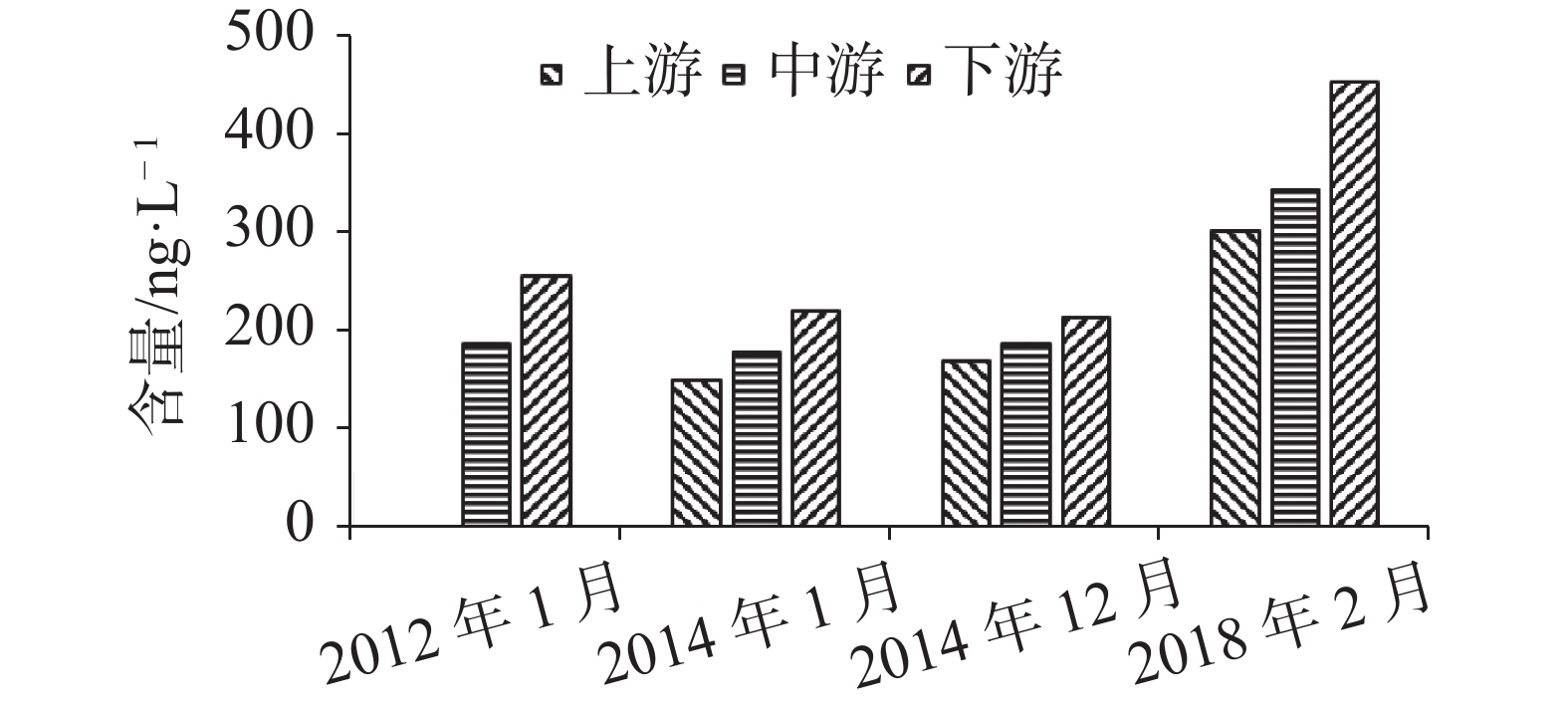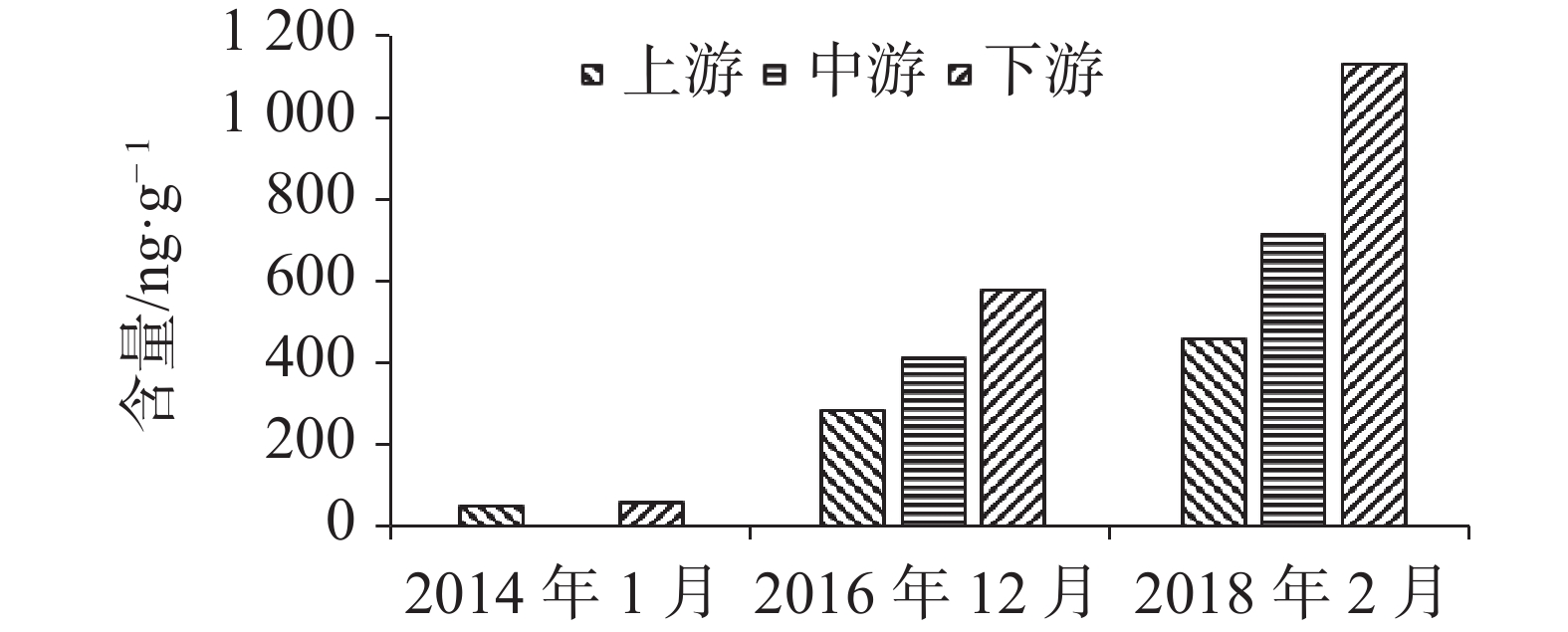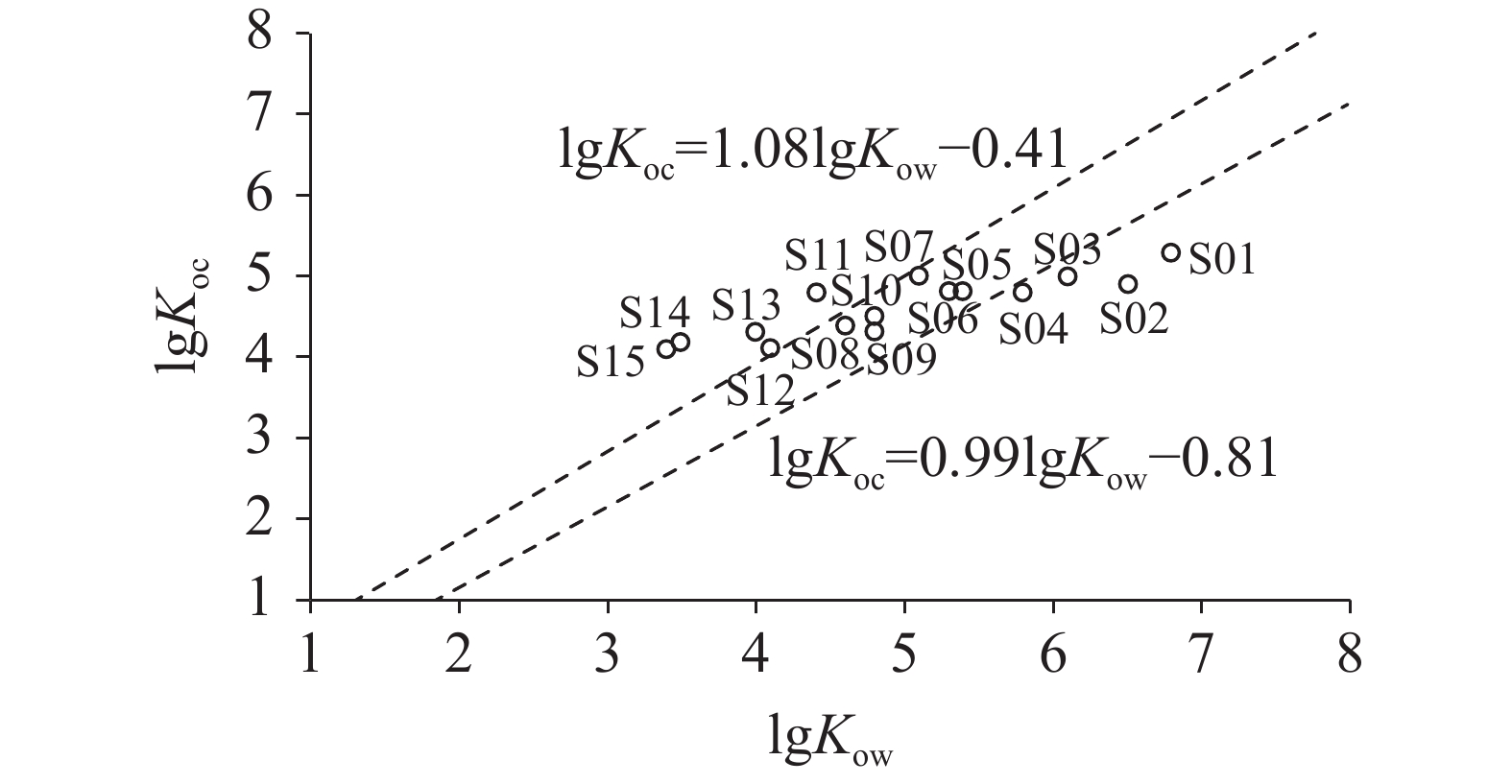Dynamic research on source and distribution of PAHs in the Qingshuiquan underground river
-
摘要:
城市化进程的不断加快,使得南宁市地下水多环芳烃(PAHs)污染日益严重,作为城市主要饮用水源地的清水泉地下河,对当地的经济和社会发展具有重要的支撑作用。文章选择南宁市清水泉地下河作为岩溶地下河的代表,以前人多年测试数据为基础,结合本次采样数据,分析水环境中PAHs的含量、分布特征和来源的多年变化情况,重点研究PAHs的分配规律。结果表明:地下水PAHs以2~3环为主,沉积物PAHs以4~6环为主,且由于污染源的增多,使得水环境中PAHs含量从上游到下游逐渐增大;不同区域的PAHs来源多年变化规律有差异,上游PAHs来源一直为生物质燃烧源,中游的PAHs来源由石油源转变为混合源,下游PAHs来源由以化石燃料燃烧源为主转变为以混合源为主;随着环数的增加,分配系数逐渐增加,且环数越大的PAHs更趋向被沉积物吸附;下游大部分采样点的PAHs在颗粒物上吸附能力较强,剩余采样点在分配过程中受溶解性有机质的影响。
Abstract:In recent years, the groundwater pollution of polycyclic aromatic hydrocarbons (PAHs) in Nanning City has been increasingly serious due to the acceleration of urbanization in this city and its dual water-bearing structure of underground and surface as well as the properties of PAHs. As a major source of drinking water for the city, the Qingshuiquan underground river plays an important role in the local economic and social development. Therefore, more research on PAHs pollution in Naning City is needed.
Covering an area of about 55.3 km2, the Qingshuiquan underground river is located in the northwest of Nanning. The strata distributed in the area are mainly upper Carboniferous (C3), Lower Cretaceous (K1) and Paleocene (E1), and the lithology is mostly thick bedded limestone. There are two underground river pipelines in the area. The groundwater mostly flows from east to west in the way of pipeline flow, and is discharged from the surface in the form of underground river outlet at S15 and flows into the Bachi river. At present, with an annual water supply capacity of 19 million square meters, the Qingshuiquan underground river provides drinking water for Yongning district of Nanning City, and is an important source of drinking water in Nanning City. In the upper reaches of the system, pollution is mainly from agricultural and domestic pollutants. In its middle and lower reaches, pollution is mainly generated from industrial enterprises, including cement plants, paper mills, quarries and gas stations.
Based on the previous test data and the sampling data of this study, the research is mainly focused on the distribution rule of PAHs with the Qingshuiquan underground river as the research object. The statistics method, isomer ratio method, distribution coefficient method and others were adopted to analyze the content, distribution characteristics and source change of PAHs in water environment over the years. Results showed that, (1) The PAHs content with different ring numbers in groundwater were in the order of 4>3>5>2>6, mainly with low ring (2-3); the content of PAHs with different ring numbers in sediment were in the order of 4>5>3>6 >2, mainly with high ring (4-6). The PAHs content in groundwater experienced an increase after a decrease, but the content in sediment saw a gradual increase, which reflected different dynamic characteristics of PAHs content in groundwater and sediment due to the urbanization and industrialization in Nanning City. (2) The spatial distribution of PAHs content in water environment was listed as follows, upstream content<middle stream content<downstream content, which may be caused by the increase of industrial pollution sources as well as PAHs emissions from upstream to downstream. The variation trend of PAHs content in groundwater in different regions was different. The content of PAHs in groundwater increased gradually in the upstream, stabilized initially and then increased sharply in the middle, and decreased first and increased afterward in the downstream. The content of PAHs in sediments of different regions presented the same trend of a gradual increase, but the increase rate was different. (3) There are also differences between the change rules over the years. The PAHs sources at upstream reaches has been generated by biomass burning, and have changed from petroleum source to the mixed one at middle reaches. At downstream, the PAHs sources has changed from fossil fuel combustion to primarily mixed source. These changes are mainly attributed to different types of pollution sources and their emissions in different areas. (4) Kp values of different ring numbers were in the order of 6>5>4>3>2. Kp values gradually increased with rise of ring numbers, and PAHs with larger ring numbers tended to be adsorbed by sediments. The lgKoc values of PAHs at S11-S15 sampling sites all exceeded the upper limit and were distributed in downstream, showing a strong adsorption capacity of PAHs on particulate matter. The lgKoc values of the remaining sampling sites are below the upper limit, reflecting the influence of dissolved organic matter on the distribution of PAHs.
-
Key words:
- polycyclic aromatic hydrocarbons /
- underground river /
- source /
- partition /
- dynamic law
-

-
表 1 同分异构体比值法判定PAHs来源的标准
Table 1. Standard for determining the sources of PAHs by isomer ratio method
PAHs比值 PAHs来源 FlA/(FlA+Pyr) 石油来源 石油类物质燃烧来源 草、木、煤燃烧来源 <0.4 0.4~0.5 >0.5 BaA/(BaA+Chr) 石油来源 石油和燃烧混合来源 燃烧来源 <0.2 0.2~0.35 >0.35 表 2 清水泉地下河∑16PAHs含量
Table 2. Content of ∑16PAHs in the Qingshuiquan underground river
PAHs 地下水/ng·L−1 沉积物/ng·g−1 最小值 最大值 平均值 最小值 最大值 平均值 2环 32.57 58.78 47.50 27.01 50.26 34.96 3环 60.94 122.77 90.81 113.55 328.17 155.41 4环 87.76 225.14 122.40 132.16 428.58 254.28 5环 30.41 126.07 72.86 47.69 366.27 190.26 6环 9.43 48.77 23.66 28.29 173.66 88.54 ∑16PAHs 287.83 478.52 356.20 418.53 1232.23 721.51 表 3 清水泉地下河∑16PAHs含量多年变化情况
Table 3. Variation content of ∑16PAHs in the Qingshuiquan underground river over the years
时间 2012年1月 2014年1月 2014年12月 2016年12月 2018年2月 地下水/ng·L−1 220.98 170.50 191.71 356.20 沉积物/ng·g−1 61.79 430.86 721.51 表 4 清水泉地下河PAHs比值多年变化情况
Table 4. Variation of PAHs ratios in the Qingshuiquan underground river over the years
时间 PAHs比值 上游 中游 下游 范围 平均值 范围 平均值 范围 平均值 2012年1月 FLA/Pyr 1.97~2.13 2.05 0.86~1.47 1.07 BaA/BaA+Chr 0.36~0.62 0.52 2018年2月 FLA/FLA+Pyr 0.52~0.61 0.55 0.42~0.58 0.51 0.45~0.48 0.46 BaA/BaA+Chr 0.37~0.49 0.42 0.24~0.39 0.33 0.29~0.33 0.31 表 5 不同环数PAHs的分配系数
Table 5. Partition coefficients of PAHs with different ring numbers
PAHs Kp/L·g−1 最小值 最大值 平均值 2环 0.75 0.75 0.75 3环 1.54 1.92 1.78 4环 1.92 2.56 2.24 5环 2.25 3.53 2.40 6环 0.83 3.91 2.53 ∑16PAHs 0.75 3.91 2.37 -
[1] 孔祥胜, 苗迎, 栾日坚, 杨奇勇, 秦愫妮. 重工业区高脆弱岩溶含水层中多环芳烃污染的初步研究[J]. 中国岩溶, 2015, 34(4):331-340.
KONG Xiangsheng, MIAO Ying, LUAN Rijian, YANG Qiyong, QIN Suni. Preliminary study on contaminant of polycyclic aromatic hydrocarbons in vulnerable karst aquifer in a heavy industry district[J]. Carsologica Sinica, 2015, 34(4):331-340.
[2] 卢海平, 孔祥胜, 邹胜章, 苗迎, 李录娟. 广西南宁朝阳溪对浅层地下水污染特征研究[J]. 中国岩溶, 2015, 34(4):395-401.
LU Haiping, KONG Xiangsheng, ZOU Shengzhang, MIAO Ying, LI Lujuan. Characteristics of pollution of the Chaoyangxi river to groundwater in Nanning of Guangxi[J]. Carsologica Sinica, 2015, 34(4):395-401.
[3] 邢淑萍, 李林凤, 符耿雪, 冯海艳, 郝志鹏, 张莘, 陈保冬. 唐山某焦化厂污染区地表水PAHs污染特征及风险评价[J]. 环境科学学报, 2021, 41(9):3586-3597.
XING Shuping, LI Linfeng, FU Gengxue, FENG Haiyan, HAO Zhipeng, ZHANG Xin, CHEN Baodong. Characteristics and risk assessment of polycyclic aromatic hydrocarbons (PAHs) in surface water in coking areas, Tangshan City, China[J]. Acta Scientiae Circumstantiae, 2021, 41(9):3586-3597.
[4] 范晨子, 刘永兵, 赵文博, 刘成海, 袁继海, 郭威, 郝乃轩. 云南安宁水系沉积污染物分布特征与风险评价[J]. 岩矿测试, 2021, 40(4):570-582.
FAN Chenzi, LIU Yongbing, ZHAO Wenbo, LIU Chenghai, YUAN Jihai, GUO Wei, HAO Naixuan. Pollution distribution characteristics and ecological risk assessment of heavy metals and polycyclic aromatic hydrocarbons in the river sediments in Anning, Yunnan Province[J]. Rock and Mineral Analysis, 2021, 40(4):570-582.
[5] 谌一涵, 沈路遥, 彭自然, 何文辉, 潘宇迪. 湖州市沿圩湾村河流多环芳烃分布及生态风险评价[J]. 上海海洋大学学报, 2021, 30(2):284-293. doi: 10.12024/jsou.20191002832
CHEN Yihan, SHEN Luyao, PENG Ziran, HE Wenhui, PAN Yudi. Distribution and ecological risk assessment of PAHs in rivers of Yanweiwan village, Huzhou[J]. Journal of Shanghai Ocean University, 2021, 30(2):284-293. doi: 10.12024/jsou.20191002832
[6] 杜士林, 丁婷婷, 董淮晋, 刘晓雪, 张亚辉, 曾鸿鹄, 何连生. 沙颍河流域水环境中多环芳烃污染及风险评价[J]. 农业环境科学学报, 2020, 39(3):601-611. doi: 10.11654/jaes.2019-1211
DU Shilin, DING Tingting, DONG Huaijin, LIU Xiaoxue, ZHANG Yahui, ZENG Honghu, HE Liansheng. Pollution and ecological risk assessment of polycyclic aromatic hydrocarbons in the water environment of Shaying river basin, China[J]. Journal of Agro-Environment Science, 2020, 39(3):601-611. doi: 10.11654/jaes.2019-1211
[7] 李慧, 李捷, 宋鹏, 程云轩, 焦立新, 杨亚铮. 东北小兴凯湖沉积物POPs污染特征及生态风险评价[J]. 环境科学, 2021, 42(1):147-158.
LI Hui, LI Jie, SONG Peng, CHENG Yunxuan, JIAO Lixin, YANG Yazheng. Characteristics and ecological risk assessment of POPs pollution in sediments of Xiaoxingkai lake in the Northeast China[J]. Environmental Science, 2021, 42(1):147-158.
[8] 宋世杰, 黄韬, 周胜, 赵留元, 毛潇萱, 高宏, 马建民. 博斯腾湖流域沉积物中多环芳烃的时空分布、来源及生态风险评价[J]. 环境科学学报, 2019, 39(8):2780-2790.
SONG Shijie, HUANG Tao, ZHOU Sheng, ZHAO Liuyuan, MAO Xiaoxuan, GAO Hong, MA Jianmin. Spatial and temporal distribution, sources, and ecological risk assessment of polycyclic aromatic hydrocarbons in sediments of the Bosten lake watershed[J]. Acta Scientiae Circumstantiae, 2019, 39(8):2780-2790.
[9] 张家泉, 胡天鹏, 邢新丽, 郑煌, 张丽, 占长林, 刘红霞, 肖文胜, 祁士华. 大冶湖表层沉积物—水中多环芳烃的分布、来源及风险评价[J]. 环境科学, 2017, 38(1):170-179.
ZHANG Jiaquan, HU Tianpeng, XING Xinli, ZHENG Huang, ZHANG Li, ZHAN Changlin, LIU Hongxia, XIAO Wensheng, QI Shihua. Distribution, sources and risk assessment of the PAHs in the surface sediments and water from the Daye lake[J]. Environmental Science, 2017, 38(1):170-179.
[10] 王军良, 梅益柔, 潘军, 张安平, 林春绵. 钱塘江齐溪水库表层沉积物中多环芳烃的分布研究[J]. 地球与环境, 2015, 43(5):547-551.
WANG Junliang, MEI Yirou, PAN Jun, ZHANG Anping, LIN Chunmian. Distribution of PAHs in sediments in Qixi reservoir of Qiantang river[J]. Earth and Environment, 2015, 43(5):547-551.
[11] Wu Yuling, Wang Xinhong, Ya Miaolei, Li Yongyu, Hong Huasheng. Seasonal variation and spatial transport of polycyclic aromatic hydrocarbons in water of the subtropical Jiulong river watershed and estuary, Southeast China[J]. Chemosphere, 2019, 234:215-223. doi: 10.1016/j.chemosphere.2019.06.067
[12] Soumita M, Simonetta C, Karla P, Ondrej A, Santosh K S, Jayanta K B. Characterization, source identification and risk associated with polyaromatic and chlorinated organic contaminants (PAHs, PCBs, PCBzs and OCPs) in the surface sediments of Hooghly estuary, India[J]. Chemosphere, 2019, 221:154-165. doi: 10.1016/j.chemosphere.2018.12.173
[13] 贾新苗, 李井懿, 杨宇, 张彤, 田胜艳. 生物扰动作用对河口沉积物中荧蒽去除的影响[J]. 生态毒理学报, 2017, 12(3):629-635.
JIA Xinmiao, LI Jingyi, YANG Yu, ZHANG Tong, TIAN Shengyan. Impact of bioturbation on the removal of fluoranthene in muddy estuarine sediment[J]. Asian Journal of Ecotoxicology, 2017, 12(3):629-635.
[14] Li Yali, Wang Chenglong, Zou Xinqing, Feng Ziyue, Yao Yulong, Wang Teng, Zhang Chuchu. Occurrence of polycyclic aromatic hydrocarbons (PAHs) in coral reef fish from the South China Sea[J]. Marine Pollution Bulletin, 2019, 139:339-345. doi: 10.1016/j.marpolbul.2019.01.001
[15] 邹艳梅, 李沅蔚, 纪灵, 杨国华, 赵世钦, 王传远. 渤海龙口湾沉积物中烃类物质的分布特征、来源解析及风险评价[J]. 环境科学研究, 2020, 33(9):2138-2147.
ZOU Yanmei, LI Yuanwei, JI Ling, YANG Guohua, ZHAO Shiqin, WANG Chuanyuan. Distribution, source and risk assessment of hydrocarbons in sediments of Longkou bay, Bohai Sea[J]. Research of Environmental Sciences, 2020, 33(9):2138-2147.
[16] 蒋忠诚, 夏日元, 时坚, 裴建国, 何师意, 梁彬. 西南岩溶地下水资源开发利用效应与潜力分析[J]. 地球学报, 2006, 27(5):495-502. doi: 10.3321/j.issn:1006-3021.2006.05.012
JIANG Zhongcheng, XIA Riyuan, SHI Jian, PEI Jianguo, HE Shiyi, LIANG Bin. The application effects and exploitation capacity of karst underground water resources in Southwest China[J]. Acta Geoscientica Sinica, 2006, 27(5):495-502. doi: 10.3321/j.issn:1006-3021.2006.05.012
[17] 夏日元, 邹胜章, 唐建生, 梁彬, 曹建文, 卢海平. 南方岩溶地区1∶5万水文地质环境地质调查技术要点分析[J]. 中国岩溶, 2017, 36(5):599-608.
XIA Riyuan, ZOU Shengzhang, TANG Jiansheng, LIANG Bin, CAO Jianwen, LU Haiping. Technical key points of 1:50, 000 hydrogeological and environmental geology surveys in karst areas of South China[J]. Carsologica Sinica, 2017, 36(5):599-608.
[18] 罗维, 杨秀丽, 邹胜章, 宁黎元. 城镇化进程下裸露岩溶区地下河水质变迁: 以贵阳上寨地下河系统为例[J]. 中国岩溶, 2017, 36(5):704-712.
LUO Wei, YANG Xiuli, ZOU Shengzhang, NING Liyuan. Variation of water quality of underground rivers in uncovered karst regions during the process of urbanization[J]. Carsologica Sinica, 2017, 36(5):704-712.
[19] 吴锡松, 张强, 姜光辉, 郭芳, 吴华英, 骆俊晖. 桂林甑皮岩岩溶地下水硝酸盐来源与转化[J]. 中国岩溶, 2020, 39(2):164-172.
WU Xisong, ZHANG Qiang, JIANG Guanghui, GUO Fang, WU Huaying, LUO Junhui. Sources and transformation of nitrate in karst groundwater of Zengpiyan site, Guilin[J]. Carsologica Sinica, 2020, 39(2):164-172.
[20] 孔祥胜, 苗迎. 大气干湿沉降:地下河多环芳烃的重要来源−以广西清水泉地下河为例[J]. 地球学报, 2014, 35(2):239-247. doi: 10.3975/cagsb.2014.02.17
KONG Xiangsheng, MIAO Ying. Atmospheric depositions, PAHs sources of an underground river: A case study of the Qingshuiquan underground river[J]. Acta Geoscientia Sinica, 2014, 35(2):239-247. doi: 10.3975/cagsb.2014.02.17
[21] 卢丽, 王喆, 裴建国. 岩溶地下河系统多介质中多环芳烃污染特征及来源解析[J]. 环境科学, 2015, 34(11):2096-2102. doi: 10.13227/j.hjkx.2015.03.015
LU Li, WANG Zhe, PEI Jianguo. Contamination characteristics and source analysis of polycyclic aromatic hydrocarbons in multimedium in karst underground river[J]. Environmental Science, 2015, 34(11):2096-2102. doi: 10.13227/j.hjkx.2015.03.015
[22] 王喆, 卢丽, 夏日元. 城市近郊型地下河水中多环芳烃分布规律与来源解析[J]. 环境化学, 2015, 36(3):862-868. doi: 10.7524/j.issn.0254-6108.2015.11.2015050201
WANG Zhe, LU Li, XIA Riyuan. Distribution and source apportionment of polycyclic aromatic hydrocarbons in water from suburban type underground river[J]. Environmental Chemistry, 2015, 36(3):862-868. doi: 10.7524/j.issn.0254-6108.2015.11.2015050201
[23] 卢丽, 王喆, 裴建国. 西南典型地下河表层沉积物多环芳烃污染特征[J]. 环境科学与技术, 2019, 42(10):51-56. doi: 10.19672/j.cnki.1003-6504.2019.10.008
LU Li, WANG Zhe, PEI Jianguo. Pollution characteristics of polycyclic aromatic hydrocarbons in surface sediments from typical underground river in Southwest China[J]. Environmental Science & Technology, 2019, 42(10):51-56. doi: 10.19672/j.cnki.1003-6504.2019.10.008
[24] 贾天琪, 雷荣荣, 武小琳, 倪涛涛, 孙树睿, 郭伟, 刘文彬. 长江下游支流水体中多环芳烃的分布及生态风险评估[J]. 环境科学, 2020, 41(5):2221-2228. doi: 10.13227/j.hjkx.201911123
JIA Tianqi, LEI Rongrong, WU Xiaolin, NI Taotao, SUN Shurui, GUO Wei, LIU Wenbin. Distribution, sources, and risk assessment of polycyclic aromatic hydrocarbons (PAHs) in tributary waters of the lower reaches of the Yangtze River, China[J]. Environmental Science, 2020, 41(5):2221-2228. doi: 10.13227/j.hjkx.201911123
[25] 吴鹏, 鲁逸人, 李慧, 郑天娇子, 程云轩, 焦立新. 津冀辽地区典型湖库沉积物PAHs污染特征及来源解析[J]. 环境科学, 2021, 42(4):1791-1800. doi: 10.13227/j.hjkx.202008046
WU Peng, LU Yiren, LI Hui, ZHENG Tianjiaozi, CHENG Yunxuan, JIAO Lixin. PAHs pollution characteristics and source analysis of typical lake and reservoir sediments in Jin-Ji-Liao Area[J]. Environmental Science, 2021, 42(4):1791-1800. doi: 10.13227/j.hjkx.202008046
[26] 丁洋, 郑煌, 黄焕芳, 张原, 陈英杰, 廖婷, 刘晋宏, 邢新丽, 祁士华. 黄河源区鄂陵湖中多环芳烃的百年沉积记录[J]. 中国环境科学, 2019, 39(8):3465-3473. doi: 10.3969/j.issn.1000-6923.2019.08.041
DING Yang, ZHENG Huang, HUANG Huanfang, ZHANG Yuan, CHEN Yingjie, LIAO Ting, LIU Jinhong, XING Xinli, QI Shihua. Centennial sedimentary records of polycyclic aromatic hydrocarbons (PAHs) in Ngoring lake at the source region of the Yellow River, Tibetan Plateau[J]. China Environmental Science, 2019, 39(8):3465-3473. doi: 10.3969/j.issn.1000-6923.2019.08.041
[27] Karickhoff S W, Brown D S, Scott T A. Sorption of hydrophobic pollutants on natural sediments[J]. Water Research, 1979, 13(3):241-248. doi: 10.1016/0043-1354(79)90201-X
[28] McGeoddy S E, Farrington J W. Sediment porewater partitioning of polycyclic aromatic hydrocarbons in three cores from Boston Harbor, Massachusetts[J]. Environmental Science & Technology, 1995, 29(6):1542-1550.
[29] Fernandes M B, Sicre M A, Boireau A, Tronczynski J. Polyaromatic hydrocarbon (PAH) distributions in the Seine River and its estuary[J]. Marine Pollution Bulletin, 1997, 34(11):857-867. doi: 10.1016/S0025-326X(97)00063-5
[30] Seth R, Mackay D, Muncke J. Estimating the organie carbon partition coefficient and its variability for hydrophobic chemicals[J]. Environmental Science & Technology, 1999, 33(14):2390-2394.
-




 下载:
下载:


